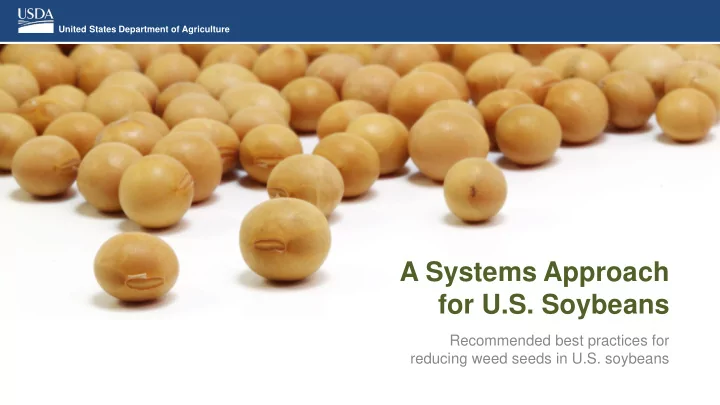

United States Department of Agriculture A Systems Approach for U.S. Soybeans Recommended best practices for reducing weed seeds in U.S. soybeans
United States Department of Agriculture Farm-to-export systems approach A suite of recommended best practices that can help reduce weed seeds in soybeans on farm, at U.S. grain elevators, and the point of export. The systems approach is voluntary. Producers, handlers, and exporters are encouraged to consider and use those best practices that are appropriate for their geographic area and their farm or business operation.
United States Department of Agriculture General Weed Management Develop a tailored weed management plan Regularly scout production areas to see which weed species are present. Consider weed biology when selecting weed management controls. Include a mix of chemical, cultural, and mechanical controls. Regularly vary weed management practices to eliminate weeds, avoid development of herbicide resistance, and discourage the buildup of any one weed type. Work with Extension agents or crop advisers to design short- and long-term plans tailored to your crop rotation, your region, and the weed species present in your fields.
United States Department of Agriculture General Weed Management Rotate crops and double-crop Use two or more crops in a rotation to lower weed densities, increase crop yields, and improve soil quality. Select rotational crops that will be sprayed with herbicides with different modes of action to minimize the evolution and spread of herbicide-resistant weeds. Consider double-cropping. The residue from the first crop helps to suppress weeds, reduce erosion, and limit pest populations while the second crop is growing. This approach can increase field yield and reduce overall herbicide applications.
United States Department of Agriculture General Weed Management Use cover crops Cover crops can increase soybean yield and suppress weeds. Select a cover crop that is suitable for your region. Remove the cover crop right before planting soybeans (as early as 1 month or as late as 5 days before planting). Consider using a cover crop between soybean rows.
United States Department of Agriculture General Weed Management Diversify herbicide use Use a variety of herbicides with different modes of action. Use a combination of pre- and post-emergence herbicides with residual effects that will last the entire crop season. Seek advice from Extension agents and crop advisers on diversifying your herbicide use, identifying the appropriate tank mixes, and tailoring the modes of action to your specific needs.
United States Department of Agriculture General Weed Management Manage weeds in field borders Control weeds in field borders, including in ditches, along access roads, and in sloughs. Frequently mow the perimeter to prevent weed reproduction and create a barrier between the field and outlying areas.
United States Department of Agriculture General Weed Management Control late-season weeds Consider using a pre-harvest herbicide or manual weed removal to control late-season weeds. Incorporate some tillage, if possible, when other weed control measures are ineffective or not feasible.
United States Department of Agriculture Planting Start with clean seed. Avoid planting soybeans in fields with a history of heavy weed infestations until the weeds are brought under control. Plant soybeans in narrow rows to allow plants to quickly form a closed canopy and out-compete weeds. Plant early in the season (late April to early May in the north; mid-April to mid-June in the south, depending on variety) to help plants compete against weeds and increase yields. Use soybean seed inoculated with nitrogen-fixing bacteria. Adjust irrigation timing and amount to minimize the benefit to weeds.
United States Department of Agriculture Harvesting Avoid harvesting soybeans growing in high-density weed patches. Adjust combine settings to remove weed seeds. Regularly clean storage bins, augurs and legs, transport vehicles, and farm equipment to prevent weed spread and avoid contaminating soybean with other grains, especially corn. Destroy weed seeds that are separated from grain or left in the field to keep them from entering the soil seed bank.
United States Department of Agriculture Handling Examine soybeans upon arrival for weed seeds, especially ragweed, Johnsongrass, cocklebur, pigweed. Consider separating weed seeds from soybeans through mechanical cleaning or other means and then destroying the seeds. Ensure bins, belts, and scales are free of other grains, especially corn, which some countries consider a noxious weed.
United States Department of Agriculture Sampling, Inspection, and Analysis USDA and U.S. trade associations will monitor weed seed and foreign material content in soybeans to evaluate the effectiveness of the systems approach. This includes: Conducting a national survey at country and export elevators. Analyzing data to identify opportunities for improving the results of the systems approach.
United States Department of Agriculture Trade Support USDA is working closely with foreign trading partners to ensure uninterrupted trade in U.S. soybeans. This includes bilateral cooperation between USDA and foreign officials to address any technical issues that might affect the entry of soybeans into the importing country.
United States Department of Agriculture Farm-to-export systems approach By participating in the systems approach, everyone along the supply chain can help maintain and enhance the value and safety of U.S. soybeans.
Recommend
More recommend